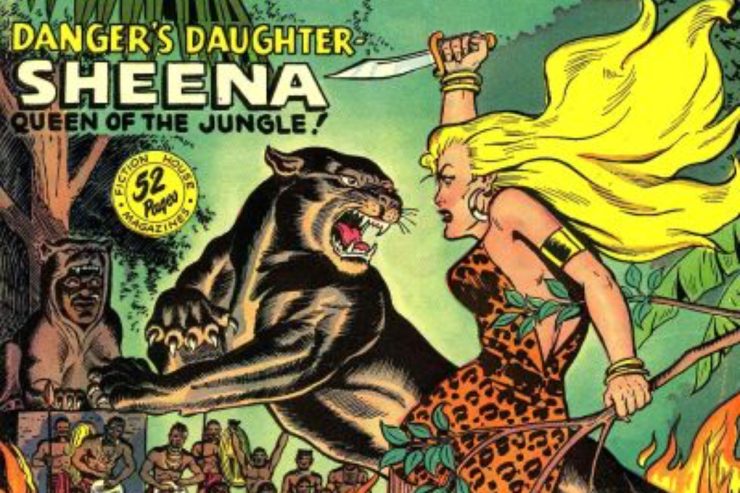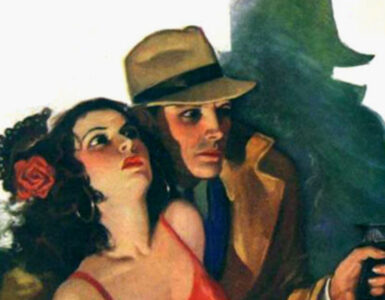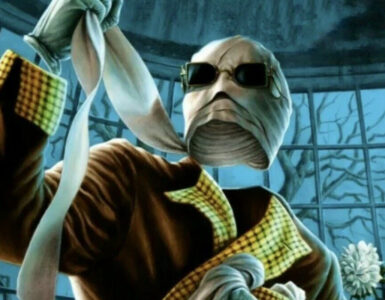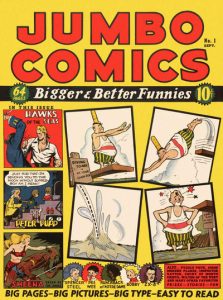 On Friday, August 5, PulpFest 50 will continue our salute to Fiction House on the occasion of the pulp magazine and comic book publisher’s 100th anniversary.
On Friday, August 5, PulpFest 50 will continue our salute to Fiction House on the occasion of the pulp magazine and comic book publisher’s 100th anniversary.
Founded in the spring of 1921 by John W. “Bearcat” Glenister and John B. “Jack” Kelly, Fiction House was a powerhouse among pulp publishers during the 1920s, selling hundreds of thousands of magazines each and every month. Unfortunately, the advent of The Great Depression in 1929 and the death of co-founder Kelly in 1932 literally pulled the plug on the company’s success.
Fiction House suspended the publication of all of its magazines at the end of 1932. Thurman T. Scott, secretary of the company, was tasked to communicate with the public about the company’s actions. He assured The New York Times that publication was only suspended and “may be resumed if conditions improve.”
Born in North Carolina, Scott had joined the company in 1930 at the behest of his father-in-law, John Glenister. Increasingly suffering from health problems, Glenister turned management of the company over to his son-in-law and retired to Southern California. When Fiction House resumed publication of Action Stories, Illustrated Football Annual, Lariat Story Magazine, and Wings in late 1933, it was T. T. Scott who was in charge of the company.
According to accounts, Thurman T. Scott was “an imposing figure: tall, red-headed, often wearing cowboy boots.” Married to one of Glenister’s daughters, it was Scott who decided to enter the comic book field in 1938.
Comic books were a relatively new field when Will Eisner and Jerry Iger approached Thurman Scott with the idea of starting a comic book. Creators and packagers of material for the growing comic book industry, Eisner and Iger reused content that they had created for the British publication Wags, and came up with Jumbo Comics #1, the first Fiction House comic book. Featuring black and white comics partially printed on colored paper — to give the illusion of color — the first issue was dated September 1938. It featured work by Dick Briefer, Will Eisner, Jerry Iger, Bob Kane, Jack Kirby, Mort Meskin, and others.
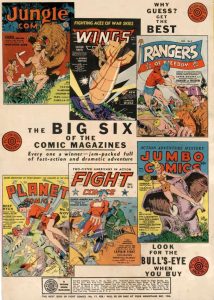 The sales of Jumbo Comics in 1938 and ’39 gave T. T. Scott all the ammunition he needed to take Fiction House into comic book publishing full on. Three new titles made their debut with cover dates of January 1940: Fight Comics, Planet Comics, and Jungle Comics. These were joined in September by Wings Comics and, in October of 1941, by Rangers of Freedom Comics. Together, these titles would be the core of Fiction House until 1954 and were billed in house ads as “The Big Six.” Over the course of 16 years, Fiction House produced 26 different titles for a total of 825 issues, but it was the Big Six that drove the company’s sales and are the most remembered by collectors today.
The sales of Jumbo Comics in 1938 and ’39 gave T. T. Scott all the ammunition he needed to take Fiction House into comic book publishing full on. Three new titles made their debut with cover dates of January 1940: Fight Comics, Planet Comics, and Jungle Comics. These were joined in September by Wings Comics and, in October of 1941, by Rangers of Freedom Comics. Together, these titles would be the core of Fiction House until 1954 and were billed in house ads as “The Big Six.” Over the course of 16 years, Fiction House produced 26 different titles for a total of 825 issues, but it was the Big Six that drove the company’s sales and are the most remembered by collectors today.
We hope that you’ll join PulpFest 50 on Friday, August 5, at 8:40 PM, for “Fiction House Comics,” a look at the pulp magazine and comic book publisher that gave us Firehair, Jane Martin, Käanga, Jungle Lord, Mysta of the Moon, Señorita Rio, Sheena, Queen of the Jungle, and many other wonderful comic book characters. Ohio-based writer, editor, and publisher Jim Beard will offer a presentation on T. T. Scott’s Fiction House line of comics. It’s part of our salute to the publisher on the occasion of the company’s 100th anniversary.
Jim Beard became a published author when he sold a story to DC Comics in 2002. Since that time he’s written official Star Wars and Ghostbusters comic book stories and contributed articles and essays to several volumes of comic book history. His prose work includes the novellas Green Hornet: How Sweet the Sting and Kolchak: The Last Temptation; co-editing and contributing to Planet of the Apes: Tales from the Forbidden Zone; a story for X-Files: Secret Agendas; three books of essays on the 1966 Batman TV series; the Sgt. Janus occult detective series of novels; Monster Earth, a shared-world giant monster anthology series; and Captain Action: Riddle of the Glowing Men, the first pulp prose novel based on the classic 1960s action figure. Jim also provided regular content for Marvel.com, the official Marvel Comics website, for over seventeen years. He is now the publisher at Becky Books and the co-publisher at Flinch Books with John C. Bruening.
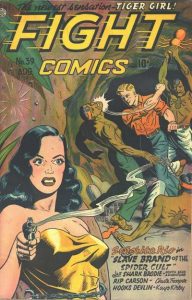 You can look for Jim on Amazon at www.amazon.com/author/jimbeard, on Facebook at www.facebook.com/thebeardjimbeard, and on Twitter at @writerjimbeard.
You can look for Jim on Amazon at www.amazon.com/author/jimbeard, on Facebook at www.facebook.com/thebeardjimbeard, and on Twitter at @writerjimbeard.
The general public is welcome to attend our evening programming events. To learn more about our schedule, please click the Programming button at the top of this page.
To enjoy our dealers’ room, click the Registration button at the top of this page to join PulpFest. And don’t forget to book a room at the DoubleTree by Hilton Pittsburgh — Cranberry in Mars, Pennsylvania. They’re going fast! Remember, you must book your room by 11:59 PM on Tuesday, July 12, to get the special convention rate.
Jumbo Comics #1, dated September 1938, was produced for Fiction House by the Eisner & Iger Studio. Although there is no cover artist credited, Will Eisner illustrated the interior pages of “Hawks of the Sea,” Bob Kane illustrated “Peter Pupp,” and Mort Meskin illustrated “Sheena, Queen of the Jungle.” These characters are featured on the oversized comic book’s cover.
Fiction House’s advertising instructed readers to “Watch for the Bull’s Eye When You Buy.” The “Big Six” advertisement pictured above is from Fight Comics #14, dated December 1941. Gene Fawcette did the cover for Wings Comics #16. The remaining covers in the ad are by Dan Zolnerowich. Both artists got their starts with the Eisner & Iger Studio, providing both cover and interior art for Fiction House comic books.
Fight Comics #39, dated August 1945, features cover art by Joe Doolin and Lily Renée (who contributed the illustration of Señorita Rio). Doolin also contributed the cover art for Planet Comics #46, dated January 1947, reproduced below.
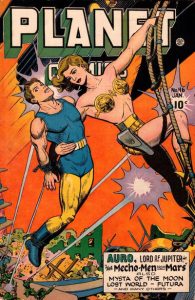 Joe Doolin got his start as a freelance artist, contributing to Weird Tales, beginning in 1925. After moving to New York City, he began contributing interior story illustrations to many pulp magazines. He turned to comic book illustration during the 1940s, contributing many covers and interior art pages to Fiction House.
Joe Doolin got his start as a freelance artist, contributing to Weird Tales, beginning in 1925. After moving to New York City, he began contributing interior story illustrations to many pulp magazines. He turned to comic book illustration during the 1940s, contributing many covers and interior art pages to Fiction House.
Lily Renée was a leading artist for Fiction House’s comic books. She worked for the firm from 1943 until 1948, contributing both ideas and artwork for “Jane Martin” “The Lost World,” “Señorita Rio,” “Werewolf Hunter,” and other series. Fiction House employed many women artists — especially during the Second World War — and Renée was truly one of the company’s stars.
Writing on his Sheena, Queen of the Jungle website, Paul Wickham suggests that the final cover artist to work on Jumbo Comics was Maurice Whitman. Completely self-taught. he entered the comic industry in the 1940s working for the Harry Chesler shop. He joined Fiction House in the late 1940s and contributed to many titles through the mid-fifties. He also illustrated covers for Fight Comics, Jungle Comics, Rangers Comics, and Wings Comics.
According to comic book historians Bill Black and Bill Feret, Maurice Whitman transformed Sheena from a mere “pin-up girl” to a savage fighter. A master of shading, Whitman’s Sheena is more muscular and realistic than the jungle queen of previous artists. Our featured image is adapted from Whitman’s cover for Jumbo Comics #133, dated March 1950.
All quotations cited in the body of our post are by Mitch Maglio, writing in Fiction House: From Pulps to Panels, From Jungles to Space, IDW Publishing, November 2017.

